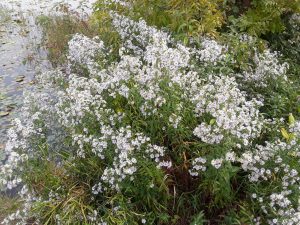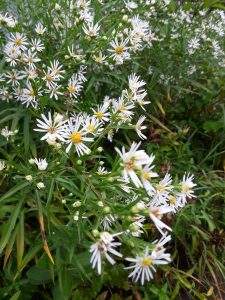Panicled Aster and Other White Asters

Symphyotrichum lancelolatum has the spectacular-sounding name of ‘panicled aster’ — apt for this very showy flower with it’s panicles of small, ray petals that cover the plant in clusters. Note the very slender leaves (up to 3/4″ wide) and 1″ to 4″ long at the base, becoming smaller (like most asters) as the leaf ascends the stem. Flowers are about 3/4″ wide with golden yellow centers that can turn reddish-toned as the blossom matures (also typical of asters). Ray color is usually white, but can sometimes be bluish.
When beginning to differentiate between the many aster species, look first for leaf shape (narrow or heart-shaped). Large-leaved asters for example, are heart-leaf in shape vs. panicled asters’ narrow leaves. Ray color can help, but asters do show a bit of variation here within species. A helpful clue lies in the habitat in which you find them. Large-leaved asters, for example, grow in shadier areas such as in woodland forests, whereas panicled asters prefer a bit more moisture and sunlight found in open fields, roadsides and meadows. And of course, comparing flower size is an important factor. Again using large-leaved aster as the model, we find they have a larger bloom size than panicled aster (1/2″ to 1.25″ across).
With their abundance of nectar and pollen, panicled aster flowers are abuzz with activity July through October, providing sustenance to bees, wasps, butterflies, flies and beetles looking for sources of nourishment. In addition to asters, many other flowers in the Aster family (such as cut-leaf coneflower), play an important role for pollinators seeking nectar and pollen-collecting late summer into autumn, when other summer flowers are spent.
Arrow leaf aster is a heart-shaped leaf aster with white flowers.

